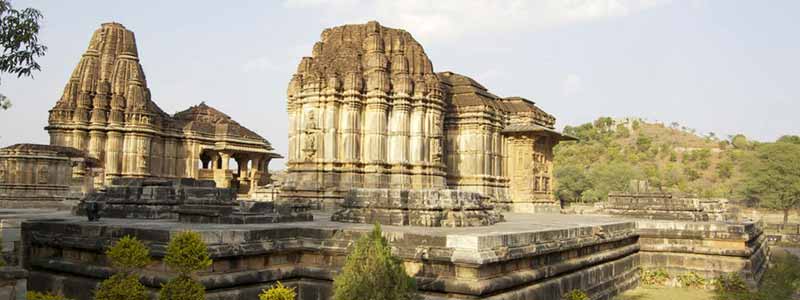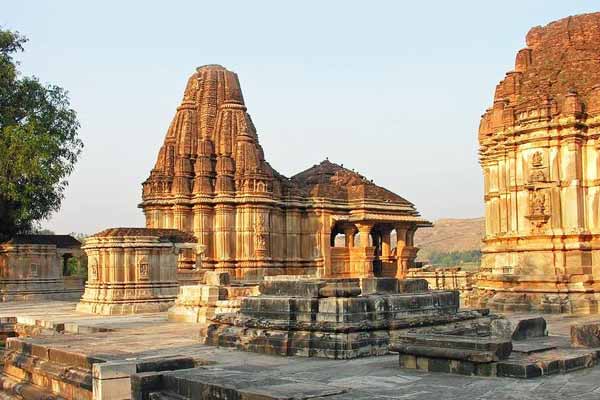Eklingji Temple Udaipur is a Hindu temple complex in the Udaipur District of Rajasthan in western India. Ek means ‘one’ while ling means ‘lingam or the life-giving a phallic symbol of Lord Shiva’. The Eklingji Temple, one of the popular pilgrimages of Rajasthan is located at a distance of 22 km away from Udaipur. It was initially built by the then King of Udaipur Bappa Rawal, on the side of 72 rooms Jain temple which housed a four-faced statue of Adinath, the first Jain Saint. It stands with the great historic significance dedicated to Lord Eklingji Temple Udaipur, the benefactor deity of the Mewar clan.
This temple is situated at the bank of the Indersagar Lake has near about 108 shrines and comes within its walls. The main shrine is a double storied building and designed with carved tower and pyramidal styled roof. Inside the complex, the main structured has a pyramid style structure and further supported by hefty pyramidal roof. On entering the temple a silver image of Nandi will welcome you to the deity of Lord Shiva. There are two other images of Nandi that are located in the temple in black stone and brass respectively.
In the middle of the temple, a striking four-faced idol of Eklingji Temple Udaipur, made of black marble is located whose height is near about 50 feet and its four faces depict four forms of Lord Shiva. The east facing part recognised as Surya, west-facing part is Lord Brahma, the north facing part is Lord Vishnu and the south facing part is Rudra. And it is further garlanded by the silver snake, acquires major attraction of the people Udaipur Tour Packages.

History of Eklingji Temple Udaipur
Eklingji is a Hindu temple complex in Udaipur District of Rajasthan in western India. Eklingji is believed to be the ruling deity of Mewar Princely State and the Ruler Maharana rules as his Dewan.
According to the 15th century text Ekalinga Mahatmya, the original temple at Eklingji Temple Udaipur was constructed by the 8th century ruler Bappa Rawal.The original temple and murti (idol) were destroyed during invasions by the Delhi Sultanate rulers. The earliest extent murti was installed by Hamir Singh (14th century), who also carried out extensive renovations to the main temple. Rana Kumbha (15th century) rebuilt the temple, in addition to constructing a Vishnu temple. His 1460 inscription describes him as “the personal servant of Eklinga”.
In late 15th century, Ghiyath Shah of Malwa Sultanate attacked Mewar, and devastated Eklingji Temple Udaipur. Kumbha’s son Rana Raimal (r. 1473–1509) defeated and captured him, and obtained a ransom for his release. With this ransom, Raimal patronized the last major rebuilding of the temple complex, and installed the present murti at the main temple Udaipur monuments.
Architecture of the Eklingji Temple
This ancient temple is built entirely of white marble and situated on a sprawling campus which houses as many as 72 holy spots such as Samadhis, muth and temples. The magnificent Shikhar is 50 feet high, with a circumference of 60 feet. The architectural style of the Eklingji Temple Udaipur is unique and the structure is a marvel of construction. The building is comprised of two storeys with an impressive pyramidal roof and strikingly beautiful carved tower.
The enormous pillared hall inside the complex is strikingly conspicuous. A magnificent silver Image of Nandi the bull welcomes visitors to the hall. Two other images of Nandi carved in black stone and brass are also housed in the temple complex. The Shivlinga is located in the center of the shrine and encircled by images of Goddess Parvati, Lord Ganesh and Lord karthikeya. The sanctum has four doors facing all the directions and the door steps are embedded with precious stones.
Statues of Goddess Saraswati and Goddess Yamuna are also found within the temple grounds. The Lalkush temple built in 971 A.D is also situated within the temple complex and is reportedly the only one of its kind in the country. The heavy silver doors leading to the main temple depict Images of Ganesh and Kartikeya. Two tanks are also found inside the temple and the water is used in the service of the Lord. A staggering 108 shrines are situated within the complex and it is encircled by long walls of hard rock.
Places to visit near Eklingji Temple Udaipur
You can find many other holy places located around the Eklingji Temple Udaipur. Each temple has its significance in the life of one or other devotee. The temples like Rathasan Devi, Pataleshwar Mahadeo, Vindhyavasini Devi, and Arbad Mata set a new definition of beautiful architecture and serene environment. Out of many, there are two very famous temples in the premises of Eklingji temple.
Sas Bahu Temple: The Sas Bahu Temple is among the rarest temples built in the 10th century. This temple is dedicated to the famous mother-in-law and daughter-in-law. The temple has some erotic images sculpted delicately on its wall surface.
Adbudji Jain temple: It is one more temple going back to the 17th century. The temple has an idol of Shanti Nath Bhagwan. The figurine is made up of black marble.
- Rathasan Devi
- Pataleshwar Mahadeo
- Vindhyavasini Devi
- Arbad Mata
- Shrinathji Temple
Best Time To Visit Eklingji Temple
Months from September to March are the best time to visit this place. If you want to see Udaipur in its most glorious form, you should plan your trip during the winters. In the summer season, the temperature rises very high and summer season is not the best time to visit Udaipur. Monsoon brings relief after the hot summers. However, Eklingji Temple Udaipur receives scanty rainfall. Winter season is, hence the best time to visit Udaipur.
How to reach Eklingji Temple
The Eklingji Temple Udaipur is a famous shrine and located in the town of Eklingji (Kailashpuri), in the state of Rajasthan. It is about 22 kms from Udaipur and linked by National Highway No. 8. One can catch a bus or taxi from Udaipur to reach the temple.
Air: Udaipur Airport also known as Maharana Pratap Airport is situated near Dabok at a distance of 22 kms from the Udaipur. A number of domestic airlines connect the city to all the major cities of India including Jaipur, Mumbai, Delhi, Mumbai and Kolkata. Cabs are available at the airport to get to hotels and resorts.
Rail: Udaipur Railway Station is quite close to the city of Udaipur. Rajasthan Railways connects Udaipur station with all the other cities of Rajasthan. There are train services running to and from Udaipur connecting Jaipur, Mumbai and Delhi. The luxurious but costly Palace on Wheels in another way to travel to Udaipur.ë_
Road: Udaipur is well connected by road to all main cities of India. Udaipur Bus Stand has regular bus services, which connect Udaipur with cities such as Delhi, Jaipur, Chittorgarh, Indore, Kota, Ajmer, Ahmedabad and Mt. Abu. Rajasthan Roadways offers the facility of Deluxe Buses and AC coaches too. You can also hire taxis and cars to reach Udaipur by road.
